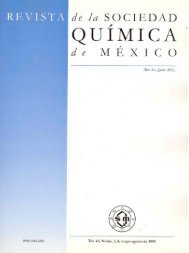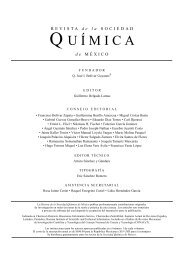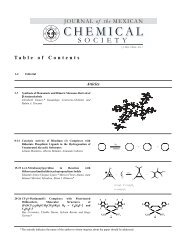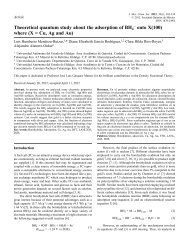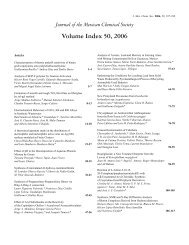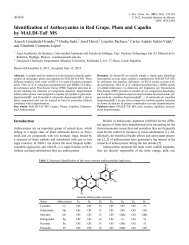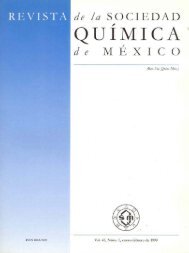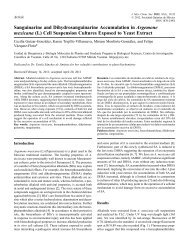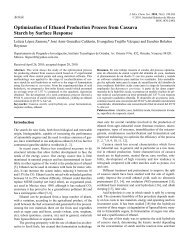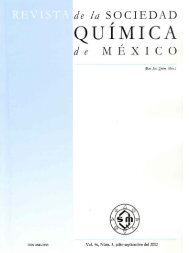SMQ-V047 N-002_ligas_size.pdf - Journal of the Mexican Chemical ...
SMQ-V047 N-002_ligas_size.pdf - Journal of the Mexican Chemical ...
SMQ-V047 N-002_ligas_size.pdf - Journal of the Mexican Chemical ...
Create successful ePaper yourself
Turn your PDF publications into a flip-book with our unique Google optimized e-Paper software.
Revista de la Sociedad Química de México, Vol. 47, Núm. 2 (2003) 117-123<br />
Investigación<br />
2D 1 H and 13 C NMR from <strong>the</strong> adducts <strong>of</strong> <strong>the</strong> dichloro carbene addition<br />
to β-ionone. The role <strong>of</strong> <strong>the</strong> catalyst on <strong>the</strong> phase transfer reaction<br />
Eduardo Díaz, *a José Luis Nava, a Héctor Barrios, a David Corona, a Ángel Guzmán, a<br />
Ma. de Lourdes Muciño, b and Aydeé Fuentes b<br />
a Instituto de Química, Universidad Nacional Autónoma de México. Circuito Exterior, Ciudad Universitaria,<br />
Coyoacán 04510 México D.F.<br />
b Facultad de Química, Universidad Autónoma del Estado de México, Toluca, Estado de México.<br />
Recibido el 9 de diciembre del 2<strong>002</strong>; aceptado el 26 de febrero del 2003<br />
En homenaje al Dr. Alfonso Romo de Vivar<br />
Abstract. Several haloderivatives were syn<strong>the</strong><strong>size</strong>d from β-ionone<br />
using CHCl 3 , NaOH and selected tetralkyl ammonium halide. 2D<br />
NMR and X-ray single crystal analysis <strong>of</strong> <strong>the</strong> products are reported.<br />
Keywords: Addition <strong>of</strong> dichlorocarbenes to β-Ionone, phase transfer<br />
addition, formation <strong>of</strong> 1,1 dichlorocyclopropanes. 1 H and 13 C NMR.<br />
Resumen. Algunos haloderivados fueron sintetizados a partir de β-<br />
ionona usando clor<strong>of</strong>ormo, hidróxido de sodio y halogenuros de<br />
tetralquilamonio selectos. Se informan los análisis por 2D RMN y<br />
rayos X de los productos.<br />
Palabras clave: Adición de diclorocarbenos a β-ionona, adición de<br />
transferencia de fase, formación de 1,1 diclorociclopropanos. RMN<br />
de 1 H y 13 C.<br />
Introduction<br />
A large number <strong>of</strong> C13-compounds formed by oxidative<br />
cleavage <strong>of</strong> carotenoids have been isolated from tobacco [1]<br />
and marine sponges [2] or <strong>the</strong>ir derivatives, originated from α<br />
and β ionones (1' and 1). In <strong>the</strong> same way, some o<strong>the</strong>r secondary<br />
metabolites as 4-oxomegastigmenos, important compounds<br />
for <strong>the</strong>ir excellent flavor characteristics are also formed<br />
in <strong>the</strong> tobacco plant from α and β ionones. O<strong>the</strong>r derivatives<br />
from ionones, isolated from rabbit urine and from <strong>the</strong><br />
secretion <strong>of</strong> <strong>the</strong> anal gland <strong>of</strong> <strong>the</strong> red fox have been obtained<br />
when α-ionone was photo-oxygenated [3, 4].<br />
The syn<strong>the</strong>sis <strong>of</strong> several damascones [5] and abscisic<br />
acids [6, 7] using readily available and inexpensive ionones as<br />
raw material encourages us to perform a reaction leading to<br />
some new functionalized and useful unsaturated compounds.<br />
Results and discussion<br />
The present paper deals with <strong>the</strong> syn<strong>the</strong>sis and structure elucidation<br />
<strong>of</strong> new representatives <strong>of</strong> this group <strong>of</strong> compounds. We<br />
describe here <strong>the</strong> products obtained when β-ionone was treated<br />
with CHCl 3 , NaOH, using as catalyst different tetralkyl<br />
quaternary ammonium salts looking to improve yields and<br />
versatility <strong>of</strong> <strong>the</strong> reaction under phase transfer conditions.<br />
Likewise, <strong>the</strong> reaction <strong>of</strong> carbenes with terpenes provides<br />
a simple means <strong>of</strong> examining <strong>the</strong> stereochemistry and regioselectivity<br />
<strong>of</strong> addition <strong>of</strong> such species to a variety <strong>of</strong> double<br />
bonds.<br />
It has been reported that in phase transfer dihalocarbene<br />
addition, stereochemistry and regioselectivity can be controlled<br />
by varying <strong>the</strong> catalyst [8-11]. Phase transfer reactions<br />
are known to be somewhat dependent on <strong>the</strong> exact reaction<br />
conditions and <strong>the</strong> formation <strong>of</strong> products apparently derived<br />
from trihalogenomethyl anion or dihalogen carbene can be<br />
controlled by varying <strong>the</strong> catalyst [9].<br />
Some years ago [12], our group reported β-Ionone when<br />
treated under CHCl 3 , NaOH and triethylbenzyl ammonium<br />
chloride (TEBAC) yield two furenones 2 and 3 which were<br />
isolated in low yield. Their structures were well supported by<br />
2D NMR as well as x-ray crystallographic analysis [13].<br />
On <strong>the</strong> mechanism <strong>of</strong> formation <strong>of</strong> <strong>the</strong>se compounds it<br />
was assumed an initial chemoselective adduct formation on<br />
<strong>the</strong> β-ionone to generate <strong>the</strong> epoxide, which is rapidly transformed<br />
to an intermediate dichloro e<strong>the</strong>r which is hydrolized<br />
to a γ-lactone where <strong>the</strong> presence <strong>of</strong> atmospheric oxygen during<br />
<strong>the</strong> reaction induced free radical dimerization [12].<br />
The low yield observed in this reaction as well as <strong>the</strong> new<br />
findings about <strong>the</strong> phase transfer reactions encourage us to<br />
undertake <strong>the</strong> study <strong>of</strong> <strong>the</strong> dichlorocarbene addition to β-<br />
ionone using different quaternary ammonium catalyst.<br />
Under <strong>the</strong> new catalyst selection, <strong>the</strong> usual γ-lactone<br />
derivatives (2 and 3) were isolated toge<strong>the</strong>r with several new<br />
compounds which display structure versatility and in addition<br />
allowed us to improve yields, as well as products ratio <strong>of</strong> <strong>the</strong><br />
obtained adducts.<br />
Structures <strong>of</strong> compounds 2 and 3 were well discussed in<br />
our previous report and <strong>the</strong>y will not be focused here.




